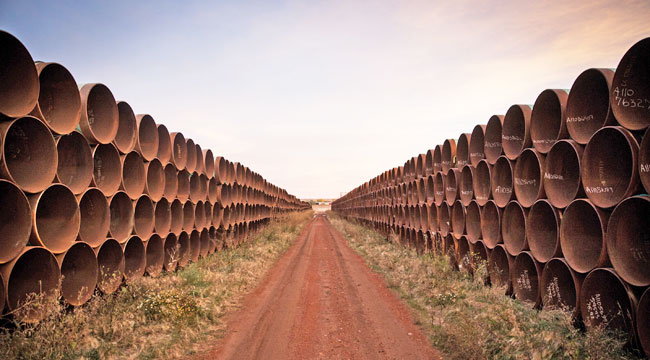
On Thursday, TransCanada revealed that a Keystone pipeline leak had dumped approximately 210,000 gallons of oil in South Dakota, and drone footage posted by the BBC confirmed the spill from the sky. The one scrap of good news was that the spill did not reach a body of water, and TransCanada claims to have contained the oil. However, Vice News has spoken with a local activist who claims to have worked alongside TransCanada. He points out that the spill contained spilled an especially dense type of crude oil. This means that the disaster could be three times worse than initially estimated, and the leak may have actually dumped up to 600,000 gallons:
Kent Moeckly, a nearby land owner and member of the Dakota Rural Action Group, told VICE News he’s concerned that the spill could be much larger though, in large part because the computers used to detect oil pressure drops don’t always detect small leaks. “Transcanada thought it was 200,000 gallons. What we found out working with Transcanada, it could very well be 600,000 gallons,” Moeckly said.
The type of oil that leaked during this spill — diluted bitumen (known also as “dilbit”) — is known, according to the New York Times, as a “garbage” type of crude oil. It’s darker and denser and less desirable within the oil industry, but they’ve resorted to recovering dilbit due to the scarcity of the preferred lighter types of crude oil. Because dilbit is so thick (akin to peanut butter), pipeline companies must dilute it in order to transport it.
As Vice points out, the dense and diluted nature of the new spill likely pushed it deep into the soil, so the full size of the leak hasn’t yet become apparent. The outlet also reminds readers that TransCanada’s last big Keystone spill (occurring in April 2016) was adjusted from 187 gallons to 16,800 gallons because they were working with diluted bitumen. So, official numbers (whenever they arrive) could be so much than previously estimated.
As of now, the portion of the Keystone pipeline that runs from Alberta to Oklahoma and Illinois remains closed while news of the spill jacked crude oil prices higher. And all of this is happening while Nebraska officials consider whether to approve TransCanada’s permit for the pipeline system’s Keystone XL extension. An update on the permit is expected within the next week.
(Via Vice, Reuters, BBC & New York Times)
